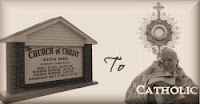 Our modern world is one full of easily recognizable brands and logos. We see a simple check mark, a bitten apple, or some golden arches and know immediately what they stand for. Humans are drawn to visible, simple representations of larger wholes.
Our modern world is one full of easily recognizable brands and logos. We see a simple check mark, a bitten apple, or some golden arches and know immediately what they stand for. Humans are drawn to visible, simple representations of larger wholes. The sign of all signs is that of the cross. This can be drawn on the forehead with the thumb, or it can be a larger sign touching the forehead, chest, left shoulder, then right shoulder. We make the sign of the cross before and after every prayer, we make it when we enter and leave the presence of Christ in a church, we make it simply as a prayer itself, in thanks or in times of suffering. It's a beautiful and visible sign which, while simple, professes the deepest mystery of our faith.
The sign of all signs is that of the cross. This can be drawn on the forehead with the thumb, or it can be a larger sign touching the forehead, chest, left shoulder, then right shoulder. We make the sign of the cross before and after every prayer, we make it when we enter and leave the presence of Christ in a church, we make it simply as a prayer itself, in thanks or in times of suffering. It's a beautiful and visible sign which, while simple, professes the deepest mystery of our faith.
Before he became Pope, Joseph Cardinal Ratzinger wrote the following in The Spirit of the Liturgy.
The most basic Christian gesture in prayer is and always will be the Sign of the Cross. It is a way of confessing Christ crucified with one's very body, in accordance with the programmatic words of St. Paul: "[W]e preach Christ Crucified, a stumbling block to Jews and folly to Gentiles, but to those who are called, both Jews and Greeks, Christ the power of God and the wisdom of God" (1 Cor 1:23). Again he says: "I decided to know nothing among you except Jesus Christ and him crucified" (2:2).To seal oneself with the sign of the Cross is a visible and public Yes to him who suffered for us; to him who in the body has made God's love visible, even to the utmost; to the God who reigns not by destruction but by the humility of suffering and love, which is stronger than all the power of the world and wiser than all the calculating intelligence of men.
The sign of the Cross is a confession of faith: I believe in him who suffered for me and rose again; in him who has transformed the sign of shame into a sign of hope and of the love of God that is present with us. The confession of faith is a confession of hope: I believe in him who in his weakness is the Almighty; in him who can and will save me even in apparent absence and impotence....
Thus we can say that in the sign of the Cross, together with the invocation of the Trinity, the whole essence of Christianity is summed up; it displays what is distinctively Christian.
We make the sign of the cross at the beginning and end of each mass. The sign of the cross leads us into the mass, and the following posts will be continuing that walk through the various prayers of the mass, and examining their significance.
Here's a video with some more info about the sign of the cross, as well as a look at a beautiful cross found in nature, in the thorns of a certain bush.
Pass through the city (through Jerusalem) and mark an X on the foreheads of those who moan and groan over all the abominations that are practiced within it. To the others I heard him say: Pass through the city after him and strike!...wipe them out! But do not touch any marked with the X. (Ez 9:4)
"Do not damage the land or the sea or the trees until we put the seal on the foreheads of the servants of our God." (Rev 7:3)
They were told not to harm the grass of the earth or any plant or any tree, but only those people who did not have the seal of God on their foreheads. (Rev 9:4)
Then I looked and there was the Lamb standing on Mount Zion, and with him a hundred and forty-four thousand who had his name and his Father's name written on their foreheads. (Rev 14:1)



2 comments:
An Eastern Orthodox friend told me why the Sign of the Cross is so precious and why it's a shame that it's become so empty- we make the sign of the cross because we believe in a God who indwells in us, and the sign of the cross represents this. He said some more stuff, but I forget :P
This reminds me of the conversation about how when we were Protestants we used to sneak and try to do the sign of the cross :P
Post a Comment